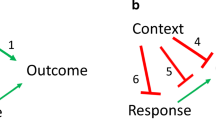Abstract
Leverpress escape/avoidance is an excellent model for assessing coping in rats. Acquisition of the leverpress response is determined by the interstimulus (signal-shock) interval, as well as the type and duration of the aversive event. One factor that has received less research attention is the safety or feedback signal. The safety signal presumably negatively reinforces leverpress responding through fear reduction. Here, we present a parametric manipulation of safety signal length and avoidance performance. All rats were trained with a 60-s tone conditioned stimulus and an intermittent 1-s, 1.0-mA footshock. Training was further accomplished with a 1−, 2−, 4−, or 6-min safety signal. Acquisition of the avoidance response was comparable at all safety signal durations. Rats trained with the shortest safety signal (1 min) exhibited more leverpresses during the safe period, a measure of anxiety. Thus, acquisition of the leverpress avoidance response was efficient regardless of safety signal duration, even though shorter periods were associated with greater anxiety.
Similar content being viewed by others
References
Berger, D. F., & Brush, F. R. (1975). Rapid acquisition of discrete-trial lever-press avoidance: effects of signal-shock interval.Journal of the Experimental Analysis of Behavior, 24, 227–239.
Berger, D. F., & Starzec, J. J. (1988). Contrasting lever-press avoidance behaviors of spontaneously hypertensive and normotensive rats (Rattus norvegicus).Journal of Comparative Psychology, 102, 279–86.
Blair, H. T., Schafe, G. E., Bauer, E. P., Rodrigues, S. M., & LeDoux, J. E. (2001). Synaptic plasticity in the lateral amygdala: a cellular hypothesis of fear conditioning.Learning & Memory, 8, 229–242.
Bolles, R. C. (1970). Species-specific defense reactions and avoidance learning.Psychological Review, 77, 32–48.
Bolles, R. C., & Grossen, N. E. (1970). Function of the CS in shuttle-box avoidance learning by rats.Journal of Comparative and Physiological Psychology, 70, 165–169.
Brush, F. R. (1966). The effects of intertrial interval on avoidance learning in the rat.Journal of Comparative and Physiological Psychology, 55, 888–892.
Candido, A., Maldonado, A., & Vila, J. (1991). Effects of duration of feedback on signaled avoidance.Animal Learning & Behavior, 19, 81–87.
D'Amato, M. R., Keller, D., & DiCara, L. (1964). Facilitation of discriminated avoidance learning by discontinuous shock.Journal of Comparative and Physiological Psychology, 58, 344–349.
D'Amato, M. R., & Schiff, D. (1964). Long-term discriminated avoidance performance in the rat.Journal of Comparative and Physiological Psychology, 57, 123–126.
Davis, H., Porter, J. W., Burton, J., & Levine, S. (1976). Sex and strain differences in leverpress shock escape behavior.Physiological Psychology, 4, 351–356.
Denny, M. R. (1971). Relaxation theory and experiments. In:Aversive Conditioning and Learning (Ed.) F. R. Brush). New York: Academic Press.
Dinsmoor, J. A. (2001). Stimuli inevitably generated by behavior that avoids electric shock are inherently reinforcing.Journal of the Experimental Analysis of Behavior, 75, 311–333.
Galvani, P. F. (1979). Feedback in discriminative avoidance learning: mechanistic versus cognitive views.Quarterly Journal of Experimental Psychology, 31, 527–533.
Galvani, P. F., & Twitty, M. T. (1978). Effects of intertrial interval and exteroceptive feedback duration on discriminative avoidance acquisition in the gerbil.Animal Learning & Behavior, 6, 166–173.
Holahan, M. R., & White, N. M. (2002). Conditioned memory modulation, freezing, and avoidance as measures of amygdala-mediated conditioned fear.Neurobiology of Learning and Memory, 77, 250–75.
Meyer, D., Cho, D., & Wesemann, A. (1960). On problems of conditioned discriminated lever-press avoidance responses.Psychological Review, 67, 224–228.
Mowrer, O. H. (1947). On the dual nature of learning: A reinterpretation of “conditioning” and “problemsolving”.Harvard Eduational Review, 17, 102–150.
Rosellini, R. A., & DeCola, J. P. (1988). The effect of feedback stimulus duration upon contextual fear and conditioned inhibition.Learning and Motivation, 19, 369–386.
Steinmetz, J. E., Logue, S. F., & Miller, D. P. (1993). Using signaled barpressing tasks to study the neural substrates of appetitive and aversive learning in rats: Behavioral manipulations and cerebellar lesions.Behavioral Neuroscience, 107, 941–954.
Author information
Authors and Affiliations
Rights and permissions
About this article
Cite this article
Brennan, F.X., Beck, K.D. & Sevatius, R.J. Leverpress escape/avoidance conditioning in rats: Safety signal length and avoidance performance. Integrative Physiological & Behavioral Science 38, 36–44 (2002). https://doi.org/10.1007/BF02734259
Issue Date:
DOI: https://doi.org/10.1007/BF02734259




